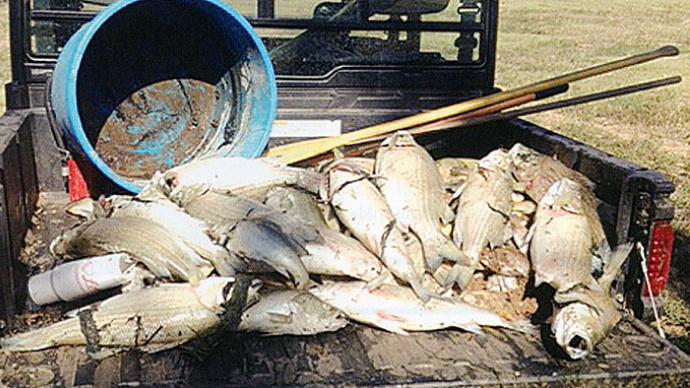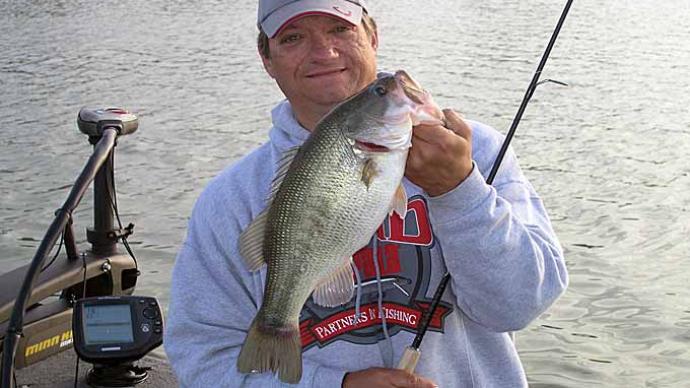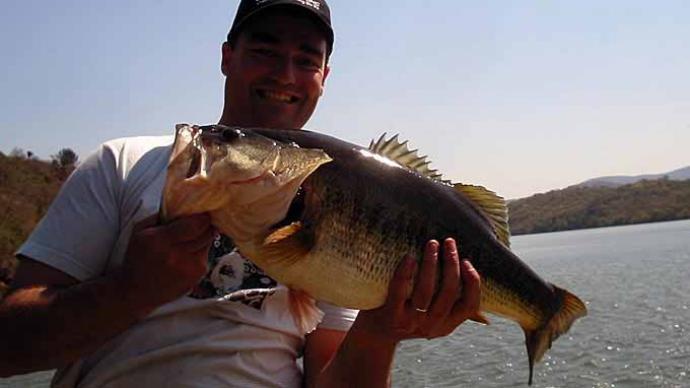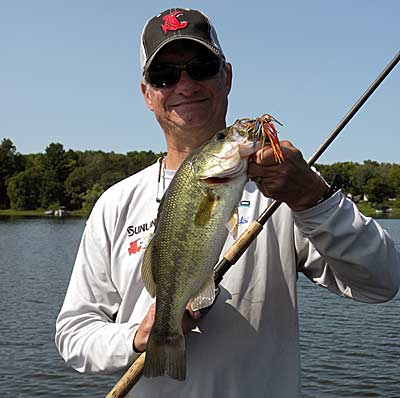
Bass fishing involves tactics and being at the top of your game. You'll need as many of these tactics in your back pocket. Through the season, bass will occupy more areas of your favorite lake, and day in and day out, bass will see the best bait presentations. For a while now, I have been using a tactic that was briefly hot in bass fishing circles. I know what is behind this disappearing act, and I can tell you that this tactic works very well when it’s done right.
The tactic that I’m talking about is a deep-water spinnerbait. It came on the bass scene strong in the late 90s and hung around for a few years. It assembled a following, but as fast as it came onto the fishermen’s radar, it fell out of sight a year or two later. At that time, I purchased a few of these special spinnerbaits that were top sellers. Dragging my feet, I had them in my boat and would throw one here or there, but I never had any success with them. So at that time, I wrote it off as I figured everyone else was doing as poorly as I was.
Deep down, I knew something behind this tactic would work, but I had to refine the bait and the presentation a little as I was having a tough time keeping my bait in the bite zone on the bottom. We all know how well a spinnerbait can work for bass as we see these results in shallower water year after year, so why would it not work when fished in a deeper water situation? At that point, I set out to see if I could solve the deep-water spinnerbait puzzle.
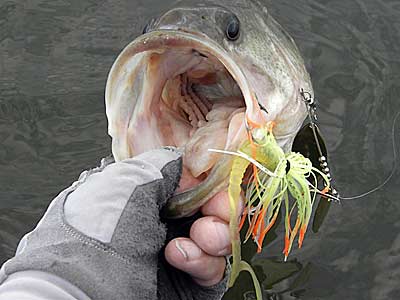
To start with, I played with a few bait options because I thought the problem was centered around keeping the bait in the bass zone long enough to let the bass find the bait and trigger strikes. Most of the baits that I had were either equipped with Colorado or Indiana blades.
I knew from experience that if you want to keep your spinnerbait above the cover and fish it clean, you have to use a Colorado or Indiana blade on your spinnerbait, as these blades give the bait lift. When I took off the Colorado blade and substituted it with a willow blade, I could better keep it in the targeted bass zone, but it still was not right.
Talking to a friend that was a tackle maker whom I was buying my shallow spinnerbaits from, I told him what I was doing. He told me to try a double willow-bladed bait as the double willow won’t have as much lift as a single willow will. He explained how the first blade of the tandem would rob water and lift from the second blade. So, I asked him to make me a handful of 1oz double willow spinnerbaits. By the start of the next season, he had a handful of baits for me to try and play with. Hitting the water with these baits, I saw a difference right away. On a long cast, I could feel the bait hitting bottom on the way back to the boat. One problem solved. Now it was time to work on the rest of the pattern. Here is what I produced.
Rod Reel and Line
It was work to throw a 1oz spinnerbait for a long time because of the bait's pull and weight. I got worn out quickly, so I started by adjusting the rod I was using. I first went from a 7ft MH baitcaster to a 7'6" MH rod. It helped overall, but I have settled in with a Denali Lithium Pro 7'10" MH crankbait rod over the years. The added length allows me to cast the bait farther and acts to distribute everything better. I team this with a Lew's BB-1 baitcaster reel with a 6.2:1 gear ratio. Using a designated crankbait reel is not to reel too fast and pull the bait off the bottom. There is a thin line in keeping the bait down, and the slower reel ratio helps to solve that problem.
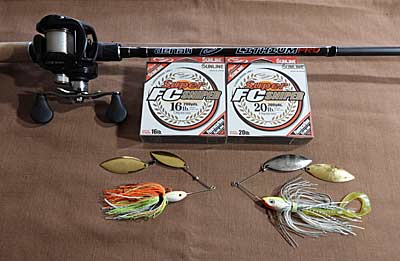
I throw a 1oz bait on Sunline 16lb Sniper FC. If I throw a 1 1/2oz, I’ll up my line size to 20lb Sunline Sniper FC.
The same anglers have asked why I don’t use braid for this tactic. I have tried it a few times with zero results. The line diameter is smaller than other lines, and I could up my line size to achieve a farther cast, and the most significant gain would be a better feel. It looks like a win-win, but I did not get a single bite when I tried it. Trying to prove it wrong, I would grab a different rod spooled with my standard line choice and catch fish. I genuinely feel that, in this case, the braided line has a hum that comes from the vibration in the line from the bait. I have no way to prove this; this is just my thought. I can’t explain it any other way, but the bass won’t hit a bait fished on braided line for some reason.
Keys To Fishing This Presentation
Make your cast and let the bait settle to the bottom. Once you notice the line go slack, reel up the slack and give the bait a pull like you’re setting the hook (off to the side). This action will get the bait and the blades moving. The blades could foul if you don’t feel them pull while reeling in the bait. You should be able to feel the blades pull when reeling. Reel as slowly as possible to keep the bait moving along the bottom. If you don’t feel the bait hitting bottom sometimes, you’re reeling too fast; slow down. You’ll learn quickly if you stop reeling. The line should go limp in a second or two. If that is not the case, your bait’s too high up off the bottom.
Treat this spinnerbait presentation just like a crankbait presentation. You want to keep the bait on the bottom, feeling the rocks on the way back to the boat. If you’re not contacting the bottom, you’ll not generate as many strikes in your day of fishing.
This deep-water spinnerbait presentation is an excellent compliment to other bottom contact baits. I often fished an area with a crankbait and followed that up with the spinnerbait tactic. This tactic is a great one-two combination to cover water with and trigger bites along the way when the bass don’t want a faster-moving bait like a crankbait. The spinnerbait’s a slower presentation and, at times, easier for the bass to track down, follow, and eat.
This presentation is a success because the bass never see it fished in this area. Yes, bass will see spinnerbaits in the shallows in the spring and fall seasons when they move shallower. But during the summer months, when they move out to their deeper water haunts, they don't see a spinnerbait every day like in some other deep-water presentations. This sets the spinnerbait apart from other presentations and tactics and makes it excel.
Make Your Bait Stand Out
Regarding my deep-water spinnerbaits, I change my blade colors to match the water color conditions I’m fishing. I’ll throw a double silver willow-bladed bait in dirty water conditions. If water conditions are dirty, I may add a white or red blade to my blade mix. When fishing in clearer water conditions, I’ll use a double gold willow combination hand’s down.
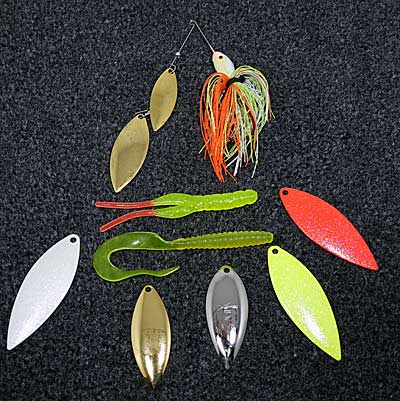
When it comes to skirts, I often fish in waters where bluegills are the number one forage, so I use a bluegill-colored skirt. However, if fishing in water dominated by shad, I would change to a shad-colored skirt.
If I’m not getting bites, I’ll change to a skirt that is still a bluegill pattern but has added bright color accents in the skirt to help get the bait noticed or seal the bite. Accent colors include chartreuse, red, or orange. These help the bass find or pick up the bait in the lower light conditions of deep water.
I always add a trailer to my spinnerbait. My top two choices are a 6" Mister Twister Grub or a Big Bite Baits Spinnerbait Twin Tail. Trailers add an attractive color to help the bass zero in and bite the bait.
One more critical point is that when fishing in and around the rocks, take the time to make sure your hook is sharp. Often during my day on the water, I’ll take the time between casts to ensure my hook point is super sharp. If not, I’ll sit down and give my hook a quick go-over.
If you sit back and think about it when was the last time your fishing partners reached into a tackle box, took out a 1oz spinnerbait, and started casting areas out in deep water? This bait and deep water are a perfect match, as it’s a great follow-up to most of the other deep-water baits you’re using to fish deep-water rocks. But think of this: the spinnerbait is a great follow-up bait to a crankbait as it gives the bass a distinctive look and moves slower, daring the bass to bite.
Next time, when you’re looking to change your deep-water game a little, grab a 1oz spinnerbait and try these tips, as it can be a game changer if given a chance.


